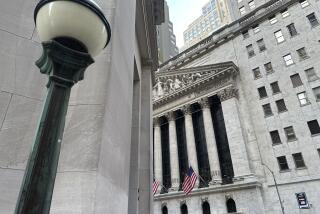Gearing Up for the ‘Long Bond’
- Share via
If you think a 4.5% annual interest yield is a great return, Uncle Sam has a deal for you: a guarantee of that rate for the next 30 years of your life.
The government on Thursday will sell $14 billion in 30-year bonds, the first such offering in more than four years. The yield, or interest rate, on the bonds is expected to be around 4.5%.
The Treasury’s revival of the 30-year security -- the so-called long bond -- is a sign of the government’s burgeoning cash needs, as the budget deficit swells again. The bond was discontinued in 2001 amid budget surpluses.
But Wall Street also has been clamoring for 30-year bonds because of a perceived strong appetite among pension funds and insurance companies for longterm fixed-rate securities. Since 2001, the longest-term conventional bond issued by the Treasury has been the 10-year T-note.
By locking in a government-guaranteed return for three decades, pension plans may be able to better match up their portfolio returns with what they’ll owe retirees over time, analysts say.
“There’s a perception of not so much a desire to buy as a need to buy” the bond on the part of pension funds, said Scott Gewirtz, head of Treasury note and bond trading at Lehman Bros.
That need may be stronger among foreign pension plans than U.S. plans, said Andrew Brenner, head of global fixed-income securities at Investec U.S.
“There are very strict rules all through Europe and especially in England as to what [pension funds] can buy,” Brenner said.
Congress also is mulling over pension reforms that could further boost bond demand by U.S. pension plans.
For Thursday’s bond sale, demand already appears robust. In “when-issued” trading -- pre-sale transactions in which investors effectively bet on the rate the government will pay -- the indicated yield on the bond has been around 4.5% in recent days.
For some investors, that return is too low considering the risk that inflation could rise over time, eroding the value of fixed returns. What’s more, investors can earn higher returns on shorter-term securities, including the 10-year T-note, which had a market yield of 4.57% on Tuesday.
“At current levels, we do not believe [the 30-year bond] has tremendous value to us,” said Brad Pacheco, a spokesman for the California Public Employees’ Retirement System, the nation’s largest public pension fund.
Many pension funds need to earn portfolio returns substantially higher than 4.5% a year to meet their obligations to retirees. For example, Iowa’s $19-billion-asset pension plan for public workers would have to earn 12% a year over the next 15 years to be fully funded, said state Treasurer Michael Fitzgerald.
Still, a 4.5% guaranteed yield could help buttress returns within diversified portfolios, given how widely stock market returns could fluctuate, said Maggie Ralbovsky, a managing director at pension consulting firm Wilshire Associates in Santa Monica.
“You need to outperform your liabilities, but you also need an anchor” in a portfolio, she said.
For Uncle Sam, revival of the 30-year bond provides the Treasury more flexibility in its financing as it projects sustained heavy borrowing. The White House on Monday said it expected a budget deficit of $423 billion this year. It estimated that the deficit would gradually decline but still would be $183 billion in 2010.
The bulk of the government’s outstanding debt will mature in the next 10 years, so sales of new 30-year issues will allow the Treasury to stretch out its debt load -- like a family converting part of an adjustable-rate mortgage to a fixed-rate loan.
And if the new bond is sold at a yield of 4.5%, it would be the lowest rate the U.S. has ever paid on debt of that maturity.
Yields on long-term government securities worldwide have tumbled since 2000, a slide that many bond market pros say has stemmed from a global glut of savings amid a relative shortage of investment opportunities.
In the U.S., long-term Treasury bond yields now are lower than shorter-term yields, a relatively unusual event. The annualized yield on six-month T-bills, for example, was 4.66% on Tuesday.
Normally, long-term bond yields are higher than shorter-term yields to compensate investors for the added risk in tying up their funds.
But as the Federal Reserve has pushed up short-term rates over the last year, some investors say they expect the economy to slow sharply in 2006. A weaker economy could mean that rates in general will be falling by year-end, said Michael Cheah, who manages the SunAmerica U.S. Government Securities mutual fund in Jersey City, N.J.
That makes it more appealing to lock in longer-term yields today, Cheah said. He sees the 10-year T-note sliding below 4.25% by year-end.
As for inflation risk, a large camp on Wall Street believes that the forces of economic globalization will subdue inflation pressures far into the future.
But some bond market pros aren’t convinced that 4.5% on a 30-year bond is enough of a return to offset the risk that inflation could resurge, or that interest rates could rise for other reasons down the road.
“If you were looking for something to tuck away for 30 years, this would not be it,” Lehman’s Gewirtz said.
*
(BEGIN TEXT OF INFOBOX)
For Individual Investors, Some Pointers on Treasury Securities
Individual investors can buy Treasury securities directly from the government or via banks and brokerage firms. Some details:
* Treasuries are sold in denominations of $1,000. Treasury bills are securities maturing in one year or less. Notes are securities maturing in two to 10 years. Bonds are securities maturing in more than 10 years.
For information on buying Treasuries directly from Uncle Sam without fees, visit www.treasurydirect.gov.
* Interest on the securities is subject to federal income tax but not to state income tax. By contrast, interest on corporate bonds and bank savings accounts is fully taxable at both levels.
* Interest rates on conventional Treasuries are fixed for the life of the securities when issued. The government makes interest payments twice a year on notes and bonds; principal is repaid when the security matures.
* Treasuries can be sold in the marketplace, but the price will depend on what has happened with interest rates. If rates on new securities are above the rate on the note or bond you own, the value of your security may be less than you paid. If market rates have fallen, your security may be worth more than you paid.
-- Tom Petruno
More to Read
Inside the business of entertainment
The Wide Shot brings you news, analysis and insights on everything from streaming wars to production — and what it all means for the future.
You may occasionally receive promotional content from the Los Angeles Times.










